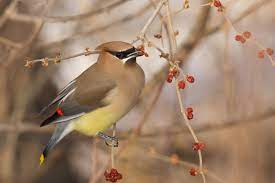The waxwing bird, scientifically known as Bombycilla garrulus, is a mesmerizing avian creature that captures hearts with its unique appearance and captivating behaviors. From its distinctive plumage to its intriguing feeding habits, the waxwing bird is a true marvel of the avian world. Join us on a journey to explore 24 captivating facts about these enchanting birds, shedding light on their habitat, behaviors, and role in ecosystems.

1. Striking Plumage: The waxwing boasts a sleek combination of soft gray, striking black masks, and waxy red tips on its wing feathers.
2. Berry Enthusiast: Known for their fondness for berries, waxwings rely heavily on fruit as a mainstay in their diet.
3. Social Gatherings: Waxwings are often seen in large, social flocks, feasting on berries and demonstrating synchronized movements.
4. Global Distribution: These birds have a widespread presence, inhabiting Northern Europe, North America, and parts of Asia.
5. Migratory Patterns: Depending on their habitat, some waxwing populations are migratory, seeking warmer climates during winter.
6. Harmonious Calls: The waxwing’s soft, high-pitched calls are musical and often used for communication within flocks.
7. Crested Elegance: Waxwings possess a unique crest on their heads that can be raised or lowered, adding to their distinctive appearance.
8. Efficient Digestion: Waxwings have specialized digestive enzymes that allow them to process berries that might be toxic to other birds.
9. Courtship Displays: During the breeding season, male waxwings perform elaborate flight displays to woo potential mates.
10. Nesting Strategies: Waxwings build loose, cup-shaped nests in trees using twigs, grass, and feathers.
11. Parental Partnership: Both male and female waxwings contribute to incubating eggs and raising their young.
12. Cultural Significance: Waxwings are admired for their elegance and have appeared in various forms of art and literature.
13. Berry Distribution: Waxwings play a crucial role in dispersing seeds by eating berries and then excreting the seeds in different locations.
14. Nomadic Habits: Depending on food availability, waxwings can exhibit nomadic behavior, moving to find suitable fruit sources.
15. Intricate Feeding Rituals: Waxwings pass berries among each other in a communal manner, fostering social bonds.
16. Irresistible Appeal: The waxwing’s distinct appearance and graceful behaviors make them a favorite among birdwatchers.
17. Urban Dwellers: These adaptable birds can be found in urban areas, especially during berry-rich seasons.
18. Unique Plumage Feature: Waxwings’ secondary wing feathers have specialized tips that help them break down waxy coatings on berries.
19. Seasonal Visitors: In some regions, waxwings are considered winter visitors, arriving when berries are abundant.
20. Ecosystem Role: Waxwings contribute to forest regeneration by aiding in seed dispersal and supporting plant diversity.
21. Conservation Concerns: Habitat loss and pesticide use can impact waxwing populations and their food sources.
22. Endearing Behavior: Waxwings often share food with each other, displaying a sense of camaraderie within their flocks.
23. Ethereal Flight: Their elegant flight patterns and synchronized movements add to the enchantment of observing waxwings.
24. Conservation Efforts: Protecting habitats, preserving fruit-bearing plants, and raising awareness are crucial for waxwing conservation.



















Add Comment